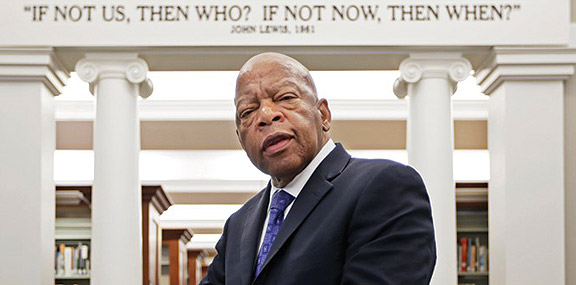‘A day like no other’
Civil Rights icon and respected leader John Lewis was the keynote speaker at the opening of Green McAdoo

On Aug. 26, 2006, U.S. Rep. John Lewis, civil rights Icon and respected leader, gave the keynote address at the dedication of the Green McAdoo Museum and Cultural Center, 50 years to the day after the Clinton 12 became the first African Americans to integrate a state-supported high school in the South: Aug. 26, 1956. Lewis died July 17, 2020.
On that day, nearly 15 years ago, the keynote speaker was a respected statesman, a respected leader in Washington, a man who sought “Good Trouble”: U.S. Rep. John Lewis.
He started with a joke about his introduction by former Tennessee State Rep. Zach Wamp.
“What I have to say will be shorter than your introduction,” Lewis told Wamp.
“I come here today just to say, ‘Thank you,’” Lewis said on that hot August day.
Lewis’ appearance at the dedication of the Green McAdoo Museum and Cultural Center came about through a series of events that started with a conversation with Tennessee Sen. Lamar Alexander and then Clinton City Manager Steve Jones.
“We knew we wanted to build the museum, but there was no way we could do that without financial help from the state or the federal government,” said Wimp Shoopman, who served as mayor of Clinton in 2006.
“So Steve Jones went to Washington and had a meeting with Alexander, and Alexander told Steve, ‘You need to speak to John Lewis about this.’”
Jones also received an introduction to Lewis from Wamp, who had worked closely with Lewis on a number of projects.
“Zach (Wamp) was always a good friend to Clinton. He also helped up get in touch with Lewis,” Shoopman said. “It just all fell into place to finally get to meet the man.”
Shoopman said given Lewis’ history with the Civil Rights movement it was an easy decision to ask him to be the keynote speaker at the dedication of the Green McAdoo Museum and Cultural Center.
But would he accept?
“We had sent out invitations to all the former living presidents at the time,” Shoopman recalled. “We didn’t hear back from any of them. Of course, looking back I don’t think they knew the significance of Green McAdoo and the Clinton 12.”
Lewis was not aware of it. He told the mayor and city manager that something should be done to get the word out about what happened in Clinton in the fall of 1956.
“I thought everybody knew about what happened,” Shoopman said. “I mean, we were on Edward R. Murrow’s show.”
But, Shoopman noted, John Lewis was just a young man at the time, maybe 15 or 16, and after three or four years the importance of what happened in Clinton in 1956 took a back seat to other Civil Rights movements.
“Representative Lewis absolutely was enthralled about what happened in Clinton, and you could tell he was pleased to be asked to be our speaker,” Shoopman said.
Lewis did not speak long that day. He joked about the heat, about how hot Tennessee was in the summer.
When he spoke of Green McAdoo, the city of Clinton and the Clinton 12, it was with admiration and thankfulness.
And then he finished, speaking less than 15 minutes.
“It was hot that day and Representative Lewis was getting into it and sweating, but you could tell he had a passion for what he was saying,” Shoopman said.
It wasn’t until afterward that the true measure of John Lewis became known to the mayor of Clinton.
“He talked to you … No, he listened to you. As much as this man had accomplished, he wanted to know about you,” Shoopman said. “What was your upbringing like? What was your family like? He wanted to know what kind of person he was talking to.”
Shoopman said he pulled rank to take Lewis to the airport that day.
“Hey, I was mayor … I should get some perks, right?” Shoopman said with a laugh. “His flight was at something like 4 p.m. and we had time to get lunch, and I’m thinking, “We’ll stop at Regas or someplace and get a big steak, right? I mean, I’m with John Lewis, a hero of the Civil Rights movement.”
Lewis had other plans.
“He said, ‘You know, I’d rather just have a Chick-fil-A. I really like their sandwiches,’” Shoopman said.
So, yeah, the man got his wish.
“In fact, when we pulled up to the drive-through, Representative Lewis looked over and said, ‘Maybe I’ll take two of those sandwiches,’” Shoopman said.
“But that’s what he was like. Just down to earth and humble. He was a really good man,” Shoopman said. “And that day ... Well, it was a day like no other.”


